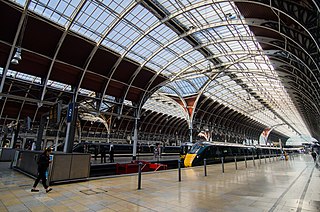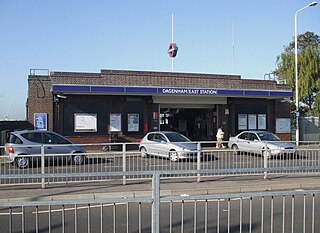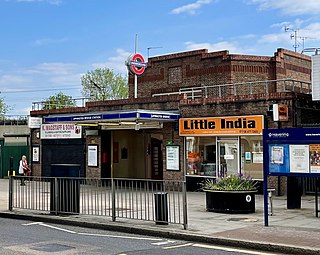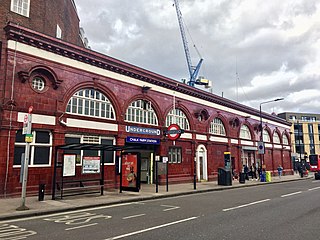
Paddington, also known as London Paddington, is a London railway station and London Underground station complex, located on Praed Street in the Paddington area. The site has been the London terminus of services provided by the Great Western Railway and its successors since 1838. Much of the main line station dates from 1854 and was designed by Isambard Kingdom Brunel. As of the 2022–23 Office of Rail & Road Statistics, it is the second busiest station in the United Kingdom, after London Liverpool Street, with 59.2 million entries and exits.

Roding Valley is a London Underground station situated in Buckhurst Hill in the Epping Forest district of Essex, straddling the boundary between that council and Greater London. The station is on the Hainault loop of the Central line between Chigwell and Woodford stations. However, geographically it is midway between Woodford and Buckhurst Hill stations. It is located between Station Way and Cherry Tree Rise. Since 2 January 2007, the station has been in Travelcard Zone 4.

Brixton is a London Underground station on Brixton Road in Brixton in the London Borough of Lambeth, South London. The station is the southern terminus of the Victoria line. The station is known to have the largest London Underground roundel on the network. The next station is Stockwell.

Regent's Park is a London Underground station 175 metres (191 yd) south of Regent's Park. It is on a northern cusp of Fitzrovia and Marylebone on the Bakerloo line, between Baker Street and Oxford Circus stations. Its access is on Marylebone Road, within Park Crescent, in Travelcard Zone 1, in which zone it is the second-least used station – it saw 3.5 million entries or exits in 2015. It is 190 metres (210 yd) west of Great Portland Street tube station on the same arterial road.

Dagenham East is a London Underground station located on the eastern side of the town of Dagenham in the London Borough of Barking and Dagenham, east London. It is on the District line between Dagenham Heathway to the west and Elm Park to the east. It is 6.4 kilometres (4.0 mi) along the line from the eastern terminus at Upminster and 27.8 kilometres (17.3 mi) to Earl's Court in central London where the line divides into numerous branches. The station has moderate usage for a suburban station, with approximately 3 million exits/entrances per year.

Upminster Bridge is a London Underground station in the Upminster Bridge neighbourhood of Upminster in the London Borough of Havering, east London. It is on the District line between Hornchurch to the west and Upminster to the east. It is 1.2 kilometres (0.75 mi) along the line from the eastern terminus at Upminster and 33 kilometres (21 mi) to Earl's Court in central London where the line divides into numerous branches. The station was opened on 17 December 1934 by the London, Midland and Scottish Railway on the local electrified tracks between Upminster and Barking that were constructed in 1932. The main station building, on Upminster Road, is of a distinctive polygonal design by William Henry Hamlyn. It has relatively low usage for a suburban station, with approximately 1.15 million passenger entries/exits in 2017.

Seven Sisters is an interchange station located in the Seven Sisters area of the London Borough of Haringey, North London for London Underground and London Overground services.

Buckhurst Hill is a London Underground station, in the Epping Forest district of Essex. It is served by the Central line and is between Woodford and Loughton. It is the larger of the two Underground stations in the town of Buckhurst Hill, with Roding Valley station being the smaller. It is the only London Underground station located in Zone 5 but not in a London Borough.

Chalk Farm is a London Underground station near Camden Town in the London Borough of Camden. It is on the Edgware branch of the Northern line between Belsize Park and Camden Town stations. For ticketing purposes, Chalk Farm falls in Travelcard Zone 2. With slightly under five million entries and exits in 2011, Chalk Farm is one of the busiest stations on the Edgware branch of the Northern line.

Epping is a London Underground station in the market town of Epping in Essex, England. The station serves as the north-eastern terminus of the Central line. Located in Travelcard Zone 6, it is one of eight London Underground stations in the Epping Forest District. The station before Epping is Theydon Bois, which is about three minutes' travelling time away.









